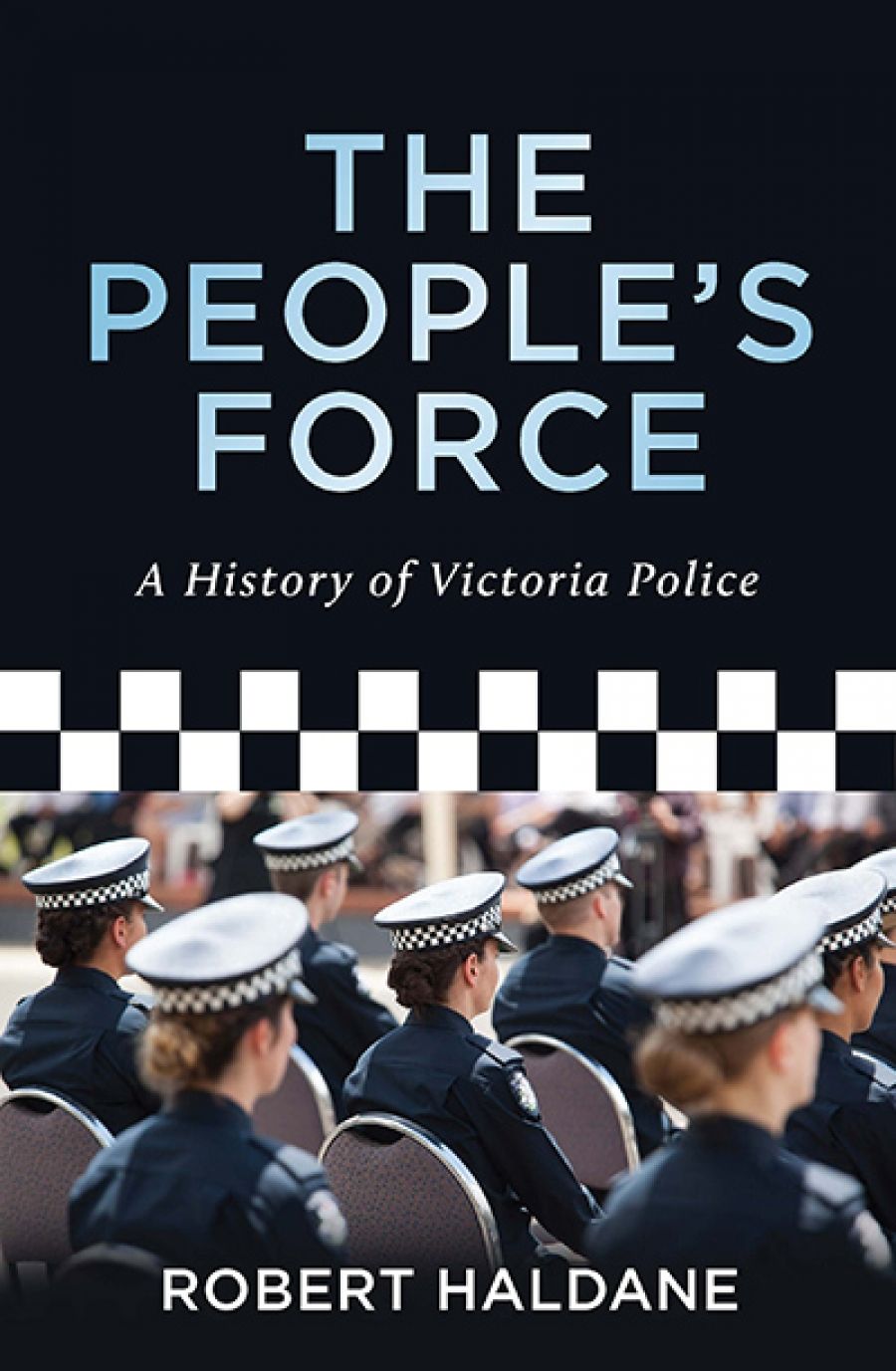
- Free Article: No
- Contents Category: Society
- Custom Article Title: John Arnold reviews 'The People’s Force: A History of Victoria Police' by Robert Haldane
- Custom Highlight Text:
Australians tend to have an ambivalent attitude to their respective police forces. We automat- ically expect that they will be there in an emergency. We share their grief when one of their number is killed while on duty, yet we regard Ned Kelly as a folk hero, even though he was responsible for the murder of three policemen in ...
- Book 1 Title: The People’s Force
- Book 1 Subtitle: A history of Victoria Police
- Book 1 Biblio: Melbourne University Press, $49.99 pb, 544 pp, 9780522864953
A policeman with postgraduate qualifications was most unusual at the time, less so now. But Haldane was no desk-based theorist. He was just as capable at locking up a drunk as he was writing an article for Police Life, the service journal he edited for many years. It is these dual qualities that make The People’s Choice such an admirable and readable history of the Victorian police.
The arrangement is understandably chronological, beginning with the three policeman sent down from Sydney in late 1835 to help with law and order in the infant settlement of Melbourne. The ensuing history of what became the Victorian Police Force in July 1853 is told mainly through accounts of the tenure of its successive commissioners. Some of them had long periods in office, but in recent times tenure has been much shorter. The current commissioner, Graham Ashton, stated in a recent press interview that the pressure and demands of the job are so high that it can only be done for five years, a statement backed by his taking three months’ stress leave in 2017.
All of the commissioners have left their mark – good, bad, indifferent – on the force. Some were innovative, but most followed a policy of steady as she goes. With promotion based for a long time on seniority, conservative attitudes amongst the force and its leaders has generally prevailed. One commissioner, Rupert Arnold, appointed in 1963, publicly stated that ‘no reforms are contem- plated by me’.
The most high-profile commissioner has been Christine Nixon, the first female appointee and arguably its first celebrity one. Nixon was a very good public speaker, popular with the media, and adopted a ‘call me Christine’ persona both within and outside the force. Haldane, however, although detailing the many good things Nixon did to help modernise the force, has reservations about her tenure.
Nixon’s successor, Simon Overland, was appointed in 2009 from four shortlisted candidates, one of whom was Ken Jones, a senior British policeman. Upon taking up his role as commissioner, Overland surprisingly appointed Jones as one of his assistant commissioners. It was an adventurous decision, but one that would come back to haunt him.
The senior hierarchy was split and became disunited, arguably dysfunctional. Jones even held meetings with the police minister behind Overland’s back before announcing his resignation in May 2011. The infighting and political interference cost Overland his job. He in turn resigned a month later at the relatively young age of forty-nine. His successor, Ken Lay, appointed from within the ranks, did much to reunite the force with his calm and open manner.

Several recurring themes come through in The People’s Force. The role, personality, and management style of the commissioners has already been mentioned. Others are the problem of recruiting suitable men, and later women, to join the force (especially those from non-Anglo-Saxon backgrounds), adjusting to social change, the challenges of the digital age, and ‘policing’ the force.
Corrupt police have always been a problem for law enforcement agencies. Haldane deals with examples of corruption squarely and strongly, knowing that the activities of a few bad eggs will always skew the public’s perception of their police force. A notable case discussed is the abortion kickbacks scandal of the 1960s and early 1970s. Reading Haldane’s account refreshed my memory of the trials and sentencing of three very senior policemen, and of the almost heroic behaviour of the abortion law reformer Bertram Wainer.

Some forty or so years later, senior Victorian police worked with, rather than against, another public hero, Rosie Batty, and her campaign against domestic violence. Here, Police Commissioner Ken Lay strongly supported Batty, insisting that police and the wider community recognise and deal with domestic violence.
On the opening pages of The People’s Force, there are quotes from laudatory reviews of the previous editions, including one from another former member of the force, Jim Cairns. These may entice browsers to read the book. And it should be read by every police officer, lawyers involved in court proceedings, and politicians who exploit crime and law enforcement as an election issue, happily ignoring statistics that show a drop in crime, for the benefit of a headline or a twenty-second digital soundbite.


Comments powered by CComment